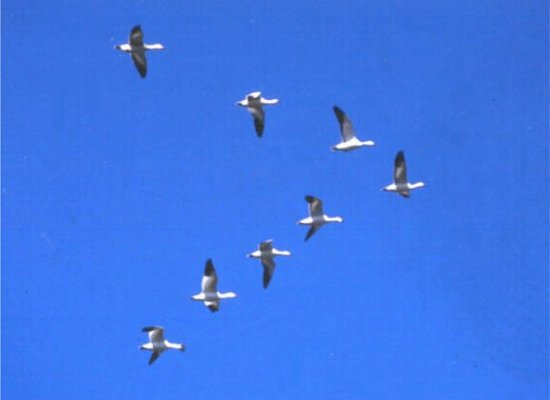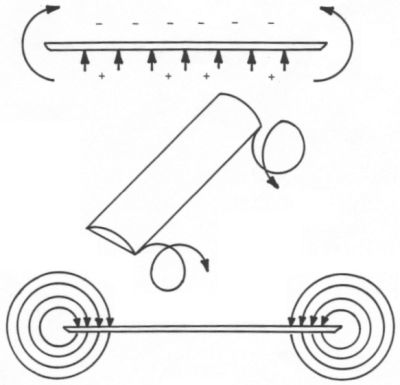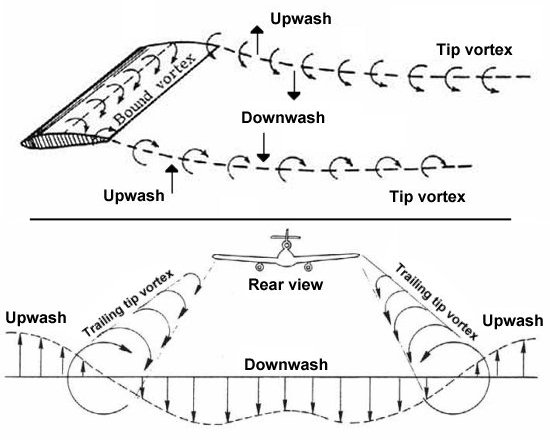|
||||||||||
| Location: Home > ask a rocket scientist > nature > q0237 | ||||||||||
|
|
||||||||||
|
||||||||||
| Location: Home > ask a rocket scientist > nature > q0237 | ||||||||||
|
|
||||||||||

Scientists who have studied formation flight believe that birds fly in this way for two reasons. The first reason is that the shape of the formation reduces the drag force that each bird experiences compared to if it were flying alone. This decrease in drag occurs thanks to the formation of wingtip vortices described in previous articles.

These vortices are generally undesirable because they create a downwash that increases the induced drag on a wing in flight. However, this downwash is also accompanied by an upwash that can be beneficial to a second wing flying behind and slightly above the first.

A bird flying in one of these upwash regions essentially gains free lift so that it can fly at a lower angle of attack. As angle of attack is reduced, the induced drag is also lowered so that the bird does not need to flap its wings as hard or as often to generate the thrust needed for forward flight. Flapping the wings less often means that the bird's muscles do not work as hard and its heart rate drops. As a result, the bird does not tire as quickly and is able to fly farther.
Researchers explored this theory by monitoring pelican heartbeats during flight. Examination of the data showed that the heart rates of pelicans flying in formation were much lower than that of a bird flying alone. Other studies have estimated that a flock of 25 birds in formation can fly as much as 70% further than a solo bird using the same amount of energy.
Theoretical investigations further support these observations of birds in formation flight. By spacing themselves apart properly, birds can achieve optimum positions that reduce the drag of every bird in the formation. However, not all birds benefit equally. Your speculation about the lead bird being in the best position is actually incorrect. This bird has to work the hardest since it flies into undisturbed air. The upwash that this bird creates improves the aerodynamics of the two behind it, and these two further improve conditions for the next two birds in line.

The majority of the benefit goes to the birds further aft, but the front bird does still gain some reduction in drag. The presence of the two birds flanking the leader helps to dissipate the downwash off the lead bird's wingtips and reduces the induced drag this bird experiences. These two flanking birds also benefit from a similar reduction in drag if outboard birds flank them as well. In other words, the birds in the middle of each of the lines forming the V are in the best position. These birds benefit from the upwash off the lead birds as well as off the trailing birds. This additional bonus means that birds in the middle experience less drag than either the lead bird or the bird at the end of each line.

Even though the V formation benefits all of the birds, the bird in the lead position has to work the hardest. When this bird tires, it will drop out of the lead position and fall further back into one of the lines of the V. Another bird from further back will rapidly move forward to take the leading position and maintain the formation. The two birds in the furthest trailing positions also tire more rapidly than those in the middle, so these positions are also rotated frequently to spread the most fatiguing locations throughout the flock. This cyclical rearrangement gives all birds the responsibility of being the leader as well as a chance to enjoy the maximum benefits of being in the middle of the formation. This sense of teamwork comes naturally since even the youngest members of the flock rapidly realize that it takes less work to fly in a V formation than it does to fly alone.
A second reason that may explain why birds fly in formation is that this orientation allows the birds to communicate more easily. The V formation provides the birds with good visual contact of each other to keep the flock together. This communication minimizes the possibility of losing birds along the way as the formation crosses vast distances during migration.
Although manned aircraft can also exploit the benefits of formation flight, it is difficult to do so since we still lag behind nature in the ability of our technology to "feel" the air and adapt to it for optimum performance. Close formation flight among a group of aircraft is often difficult to maintain because of the turbulence created by the lead aircraft. Perhaps one day we will be able to develop advanced technologies that make aircraft as sensitive to their surroundings as the body of a bird is today. We may then be able to make better use of formation flight to improve the efficiency of flying vehicles.

However, military planes do still operate in V formations, but they are typically spaced too far apart to enjoy the
benefits of reduced drag. These aircraft instead fly in formation primarily to maintain visibility of all the
aircraft in the squadron in the same way that birds do.
- answer by Jeff Scott, 17 July 2005
Related Topics:
Why do flocks of birds fly in a circle over the same place over and over again?
Read More Articles:


|
Aircraft | Design | Ask Us | Shop | Search |

|
|
| About Us | Contact Us | Copyright © 1997-2025 | |||
| Location: Home > ask a rocket scientist > nature > q0237 | |||
|
|
|||